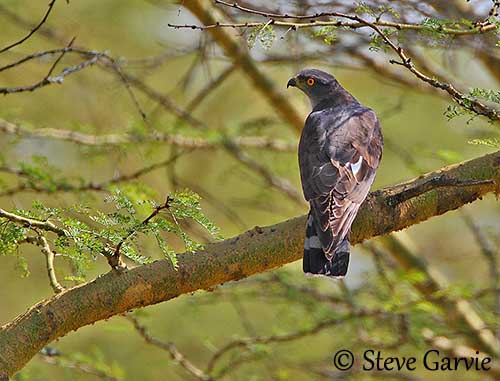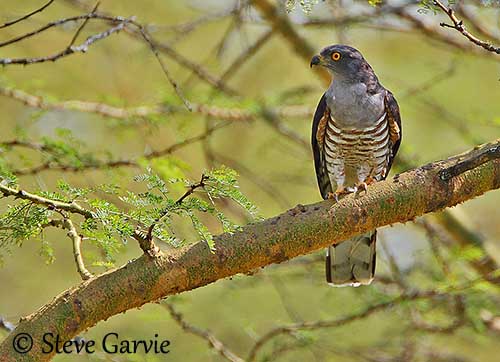
Fr: Baza coucou
All: Kuckucksweih
Esp: Baza Africano
Ita: Baza africano
Nd: Afrikaanse Koekoekswouw
Sd: Afrikansk gökfalk
Photographer:
Steve Garvie
RAINBIRDER Photo galleries
Text by Nicole Bouglouan
Sources:
HANDBOOK OF THE BIRDS OF THE WORLD Vol 2 by Josep del Hoyo-Andrew Elliot-Jordi Sargatal - Lynx Edicions - ISBN: 8487334156
BIRDS OF PREY OF AFRICA AND ITS ISLANDS by Alan and Meg Kemp - Struik Publishers - ISBN: 1770073698
BIRDS OF EAST AFRICA vol 1 by C.A.W. Guggisberg – Mount Kenya Sundries Ltd. – ISBN: 9966889051
BIRDS OF AFRICA SOUTH OF THE SAHARA by Ian Sinclair and Peter Ryan - Princeton University Press Princeton and Oxford - ISBN: 0691118159
BirdLife International (BirdLife International)
Global Raptor Information Network - Working to Conserve Birds of Prey in nature
African Cuckoo-Hawk
Aviceda cuculoides
Accipitriformes Order – Accipitridae Family
INTRODUCTION:
The African Cuckoo-Hawk is a long-winged raptor with short, pointed crest, and two tooth-like indentations on the edge of the upper mandible.
The Aviceda species were related to falcons because of the notched bill, but finally, it is mostly closely related to kites. They are also called Cuckoo-Falcons and Bazas.
DESCRIPTION OF THE BIRD:
Biometrics:
Length: 40 cm
Wingspan: 91 cm
Weight: 220-296 g
The adult has dark grey to blackish-brown upperparts. The rump is black, barred white. The black tail feathers show three grey bands and a narrow greyish-white terminal band. The flight feathers are dark grey and narrowly barred paler grey.
On the underparts, chin, throat and upper breast are pale grey, whereas lower breast and underwing-coverts are white, broadly barred dark rufous. Lower belly, vent and undertail-coverts are white.
On the pale grey head, the face is slightly paler. There is a small crest, often folded, with pale centre and rufous patch on nape.
The bill is black with double-notched cutting and deep yellow cere. The eyes are deep red-brown in male and yellow in female. The short, bare legs and feet are deep yellow too.

Both sexes are similar in size and plumage, except the eyes.
The juvenile has brown upperparts with pale rufous-tipped feathers. The underparts are white, heavily streaked black, mostly spotted on flanks. We can see a white streaking on crown, forehead and eyebrow. The throat is white with indistinct brown streaks. The face shows a dark brown mask. The crest is less conspicuous than in adults. The eyes are dark brown.
The subadult resembles adult but is has rufous-tinged chest and finely barred grey underparts. The eyes are pale yellow.
SUBSPECIES AND RANGE:
The African Cuckoo-Hawk has three subspecies which differ in size, extent of barring and intensity of plumage colour.
A.c. cuculoides (here described) is found in woodland from Senegal, E to SW Ethiopia, and S to Nigeria and N Zaire.
A.c. batesi occurs in lowland rainforest from Sierra Leone, E to Uganda and S to N Angola. This one has darker upperparts and heavy barring on underparts.
A.c. verreauxii is found in woodland and coastal, riparian and montane forests, from Kenya, S to N Namibia and South Africa. It has distinctive white barred wing lining.
HABITAT:
The African Cuckoo-Hawk frequents dense woodland or second growth forest mixed with cultivated areas, but it is also present in exotic plantations in more open savanna, up to 3000 metres of elevation.
It usually avoids desert and semi-desert, but it can be seen in suburban areas too.
CALLS AND SONGS: SOUNDS BY XENO-CANTO
The African Cuckoo-Hawk is noisy before breeding, giving loud, far-carrying whistling calls “teee-oooo” and shorter ones “tittit-eoo”.
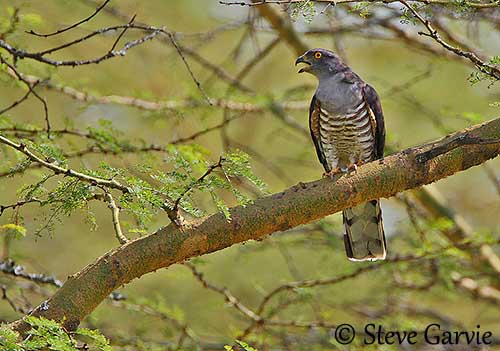
BEHAVIOUR IN THE WILD:
The African Cuckoo-Hawk feeds mainly on lizards, especially chameleons, and large insects such as grasshoppers, mantids and caterpillars. But its diet can be more varied too, including beetles, wasps, termites, crabs, fish, small birds taken in the nest, and bats.
It often hunts from a perch, waiting for long periods within vegetal cover. Once a prey is detected, it swoops slowly down to catch it from foliage or branch, but also by walking around or hopping along the ground.
It may sometimes perform aerial sallies and hawk flying insects. Or it flies low over the open vegetation before to drop onto the prey.
The African Cuckoo-Hawk often stands horizontally on branch with the wings slightly drooped. It prefers to perch under cover or below the canopy, rather than on open sites. It is often found in pairs.
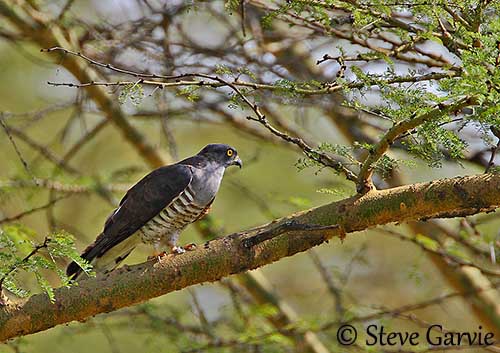
During the breeding season, it performs courtship displays and calls from perches. The pair engages in twisting display flights high in the air, usually at dawn and dusk. These flights consist of several undulating swoops and dives, with steep sideway banking, in order to display the rufous underwing-coverts.
They may soar in small groups above the forest, while calling to one another.
The African Cuckoo-Hawk is mainly resident in most part of the range, but some seasonal movements can be observed, often related to prey availability such as chameleons and insects.
The flight is fast and direct, with wingbeats interspersed with glides. But it soars rarely. The flight displays are spectacular.
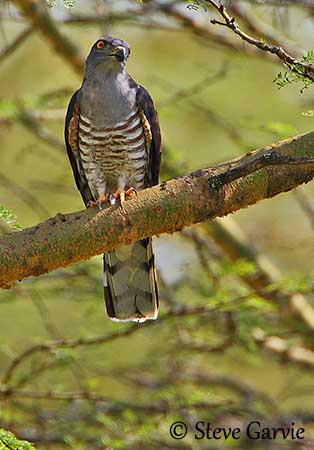
REPRODUCTION OF THIS SPECIES:
The breeding season usually takes place during the rainy season, but the laying period may vary according to the range.
The African Cuckoo-Hawk nests in forest. The nest is placed fairly high up in a forest tree, often Eucalyptus, and well concealed among the foliage. It is a typical platform made with sticks, roots and twigs with leaves still attached. The cup is lined with grass, green leaves and wool.
The female lays 2-3 white eggs with bold brown spots. Both sexes share the incubation during 32-33 days. At hatching, the chicks have white down. They are fed on insects by both parents. They fledge about 5-6 weeks after hatching, and still depend on adults for one week or more.
PROTECTION / THREATS / STATUS:
The African Cuckoo-Hawk is widespread throughout its large range, but it is uncommon and difficult to see due to its secretive habits.
This species is affected by the loss of its forest habitat, and it is preyed upon by larger raptors.
However, the population appears stable and the species is not currently threatened.
